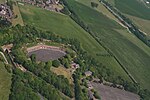The Port of Dover is a cross-channel ferry, cruise terminal, maritime cargo and marina facility situated in Dover, Kent, south-east England. It is the nearest English port to France, at just 34 kilometres (21 mi) away, and is one of the world's busiest maritime passenger ports, with 11.7 million passengers, 2.6 million lorries, 2.2 million cars and motorcycles and 80,000 coaches passing through it in 2017, and with an annual turnover of £58.5 million a year. This contrasts with the nearby Channel Tunnel, the only fixed link between the island of Great Britain and the European mainland, which now handles an estimated 20 million passengers and 1.6 million trucks per year.
The modern port facility features a large artificial harbour constructed behind stone piers and a defensive concrete breakwater. The port is divided into two main sections: the Eastern Docks serve as the main cross-channel ferry terminal, while the Western Docks contain a cruise ship terminal and a yacht marina along with cargo facilities.
The Port of Dover has a long history and possesses several listed buildings and structures. The port is owned and operated by the Dover Harbour Board, a statutory corporation formed by royal charter in 1606 by King James I. Most of the board members of the Dover Harbour Board are appointees of the Department for Transport. The port has its own private police force, the Port of Dover Police. The current port traffic volumes and urban population categorize Dover as a Large-Port Town.









